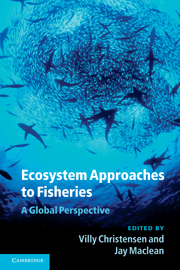Book contents
- Frontmatter
- Contents
- List of contributors
- Foreword
- Preface
- Acknowledgments
- 1 Introduction: toward ecosystem-based management of fisheries
- I Life in the oceans
- II Evaluating impact on marine life
- III Managing living resources
- 10 Assessment of exploited stocks of tropical fishes: an overview
- 11 Ecosystem-based fisheries management in the face of climate change
- 12 Progress in the use of ecosystem modeling for fisheries management
- IV The human side
- V Impacting policy
- Index
- References
12 - Progress in the use of ecosystem modeling for fisheries management
Published online by Cambridge University Press: 05 June 2012
- Frontmatter
- Contents
- List of contributors
- Foreword
- Preface
- Acknowledgments
- 1 Introduction: toward ecosystem-based management of fisheries
- I Life in the oceans
- II Evaluating impact on marine life
- III Managing living resources
- 10 Assessment of exploited stocks of tropical fishes: an overview
- 11 Ecosystem-based fisheries management in the face of climate change
- 12 Progress in the use of ecosystem modeling for fisheries management
- IV The human side
- V Impacting policy
- Index
- References
Summary
INTRODUCTION
We are moving toward ecosystem-based management of fisheries, and it is clear that ecosystem modeling is an important tool for evaluating scenarios and trade-offs as part of such a move. This chapter evaluates the extent of ecosystem modeling as an active research field, the potential usefulness of the models for fisheries management, and actual use of ecosystem models in fisheries management. In addition we present some recommendations for how the move toward ecosystem-based management can be supported through an adaptive environmental assessment and management process.
It is important at the outset to be careful about what it means to “use” a model in fisheries management. At one extreme, imagine taking model predictions at face value and applying them blindly in setting reference points and regulations; some managers seem to hope for or expect such models to appear, presumably as absolution or excuse for not making thoughtful choices in the face of uncertainty. No fisheries model, whether a highly “precise” single-species assessment or a crude ecosystem biomass flow scheme, will ever be reliable enough to use in such an uncritical way, if for no other reason than unpredictability in environmental conditions. At the opposite extreme, we can certainly use even very simple trophic interaction calculations to screen qualitative policy options and answer very basic questions raised in management settings (e.g., could predation rates by some particular predator that fishers do not like be high enough to ever justify a culling policy?).
Information
- Type
- Chapter
- Information
- Ecosystem Approaches to FisheriesA Global Perspective, pp. 189 - 206Publisher: Cambridge University PressPrint publication year: 2011
References
Accessibility standard: Unknown
Why this information is here
This section outlines the accessibility features of this content - including support for screen readers, full keyboard navigation and high-contrast display options. This may not be relevant for you.Accessibility Information
- 29
- Cited by
